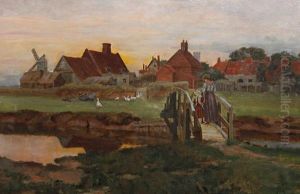George Edward Cook Paintings
George Edward Cook was a prominent New Zealand artist known for his landscape paintings, watercolors, and sketches that captured the natural beauty and burgeoning settlements of New Zealand in the 19th century. Born on December 29, 1832, in England, Cook migrated to New Zealand in the early 1850s, seeking new opportunities and inspired by the potential of the young British colony.
Cook's early years in New Zealand were spent in the Otago region, where he quickly became involved in the local art scene. He was largely self-taught, but his keen observation skills and natural talent allowed him to produce works that were both accurate and aesthetically pleasing. His paintings often featured the rugged landscapes of New Zealand, from the dense forests and coastal scenes to the majestic mountains and tranquil rivers. He also captured the human element, depicting the lives of Māori and European settlers as they intersected and evolved.
Throughout his career, Cook exhibited his works in various art shows and became a respected member of the art community in New Zealand. He was not only a painter but also a skilled draughtsman, and his drawings and sketches provide valuable historical insight into the early days of New Zealand's development. His work was significant in promoting the unique beauty of New Zealand to both locals and those abroad, contributing to a burgeoning sense of national identity.
George Edward Cook continued to paint and contribute to the New Zealand art world until his death on November 23, 1922. Today, his works are held in numerous public collections, including the Museum of New Zealand Te Papa Tongarewa and the Alexander Turnbull Library. Through his art, Cook has left a lasting legacy, offering a window into the past and celebrating the natural and cultural heritage of New Zealand.
